Intel Core i7-10700 vs Core i7-10700K Review: Is 65W Comet Lake an Option?
by Dr. Ian Cutress on January 21, 2021 10:30 AM EST- Posted in
- CPUs
- Intel
- Core i7
- Z490
- 10th Gen Core
- Comet Lake
- i7-10700K
- i7-10700
CPU Tests: Rendering
Rendering tests, compared to others, are often a little more simple to digest and automate. All the tests put out some sort of score or time, usually in an obtainable way that makes it fairly easy to extract. These tests are some of the most strenuous in our list, due to the highly threaded nature of rendering and ray-tracing, and can draw a lot of power. If a system is not properly configured to deal with the thermal requirements of the processor, the rendering benchmarks is where it would show most easily as the frequency drops over a sustained period of time. Most benchmarks in this case are re-run several times, and the key to this is having an appropriate idle/wait time between benchmarks to allow for temperatures to normalize from the last test.
Blender 2.83 LTS: Link
One of the popular tools for rendering is Blender, with it being a public open source project that anyone in the animation industry can get involved in. This extends to conferences, use in films and VR, with a dedicated Blender Institute, and everything you might expect from a professional software package (except perhaps a professional grade support package). With it being open-source, studios can customize it in as many ways as they need to get the results they require. It ends up being a big optimization target for both Intel and AMD in this regard.
For benchmarking purposes, we fell back to one rendering a frame from a detailed project. Most reviews, as we have done in the past, focus on one of the classic Blender renders, known as BMW_27. It can take anywhere from a few minutes to almost an hour on a regular system. However now that Blender has moved onto a Long Term Support model (LTS) with the latest 2.83 release, we decided to go for something different.
We use this scene, called PartyTug at 6AM by Ian Hubert, which is the official image of Blender 2.83. It is 44.3 MB in size, and uses some of the more modern compute properties of Blender. As it is more complex than the BMW scene, but uses different aspects of the compute model, time to process is roughly similar to before. We loop the scene for at least 10 minutes, taking the average time of the completions taken. Blender offers a command-line tool for batch commands, and we redirect the output into a text file.

The 10700K takes a small lead.
Corona 1.3: Link
Corona is billed as a popular high-performance photorealistic rendering engine for 3ds Max, with development for Cinema 4D support as well. In order to promote the software, the developers produced a downloadable benchmark on the 1.3 version of the software, with a ray-traced scene involving a military vehicle and a lot of foliage. The software does multiple passes, calculating the scene, geometry, preconditioning and rendering, with performance measured in the time to finish the benchmark (the official metric used on their website) or in rays per second (the metric we use to offer a more linear scale).
The standard benchmark provided by Corona is interface driven: the scene is calculated and displayed in front of the user, with the ability to upload the result to their online database. We got in contact with the developers, who provided us with a non-interface version that allowed for command-line entry and retrieval of the results very easily. We loop around the benchmark five times, waiting 60 seconds between each, and taking an overall average. The time to run this benchmark can be around 10 minutes on a Core i9, up to over an hour on a quad-core 2014 AMD processor or dual-core Pentium.
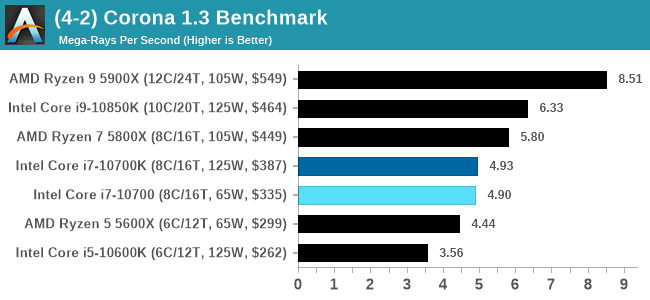
The 10700K takes a small lead.
Crysis CPU-Only Gameplay
One of the most oft used memes in computer gaming is ‘Can It Run Crysis?’. The original 2007 game, built in the Crytek engine by Crytek, was heralded as a computationally complex title for the hardware at the time and several years after, suggesting that a user needed graphics hardware from the future in order to run it. Fast forward over a decade, and the game runs fairly easily on modern GPUs.
But can we also apply the same concept to pure CPU rendering? Can a CPU, on its own, render Crysis? Since 64 core processors entered the market, one can dream. So we built a benchmark to see whether the hardware can.
For this test, we’re running Crysis’ own GPU benchmark, but in CPU render mode. This is a 2000 frame test, with medium and low settings.
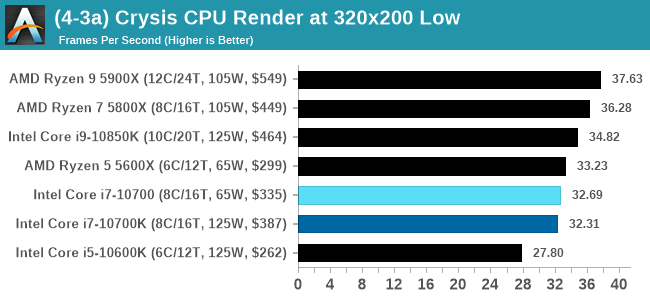
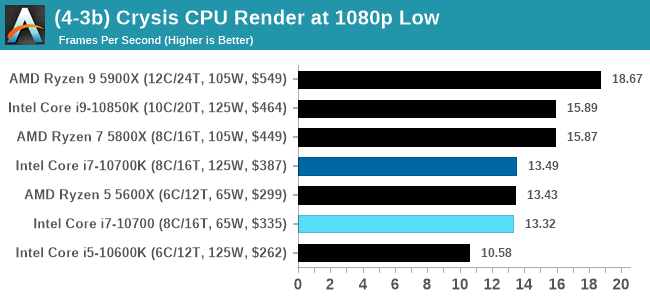
Almost playable.
POV-Ray 3.7.1: Link
A long time benchmark staple, POV-Ray is another rendering program that is well known to load up every single thread in a system, regardless of cache and memory levels. After a long period of POV-Ray 3.7 being the latest official release, when AMD launched Ryzen the POV-Ray codebase suddenly saw a range of activity from both AMD and Intel, knowing that the software (with the built-in benchmark) would be an optimization tool for the hardware.
We had to stick a flag in the sand when it came to selecting the version that was fair to both AMD and Intel, and still relevant to end-users. Version 3.7.1 fixes a significant bug in the early 2017 code that was advised against in both Intel and AMD manuals regarding to write-after-read, leading to a nice performance boost.
The benchmark can take over 20 minutes on a slow system with few cores, or around a minute or two on a fast system, or seconds with a dual high-core count EPYC. Because POV-Ray draws a large amount of power and current, it is important to make sure the cooling is sufficient here and the system stays in its high-power state. Using a motherboard with a poor power-delivery and low airflow could create an issue that won’t be obvious in some CPU positioning if the power limit only causes a 100 MHz drop as it changes P-states.

V-Ray: Link
We have a couple of renderers and ray tracers in our suite already, however V-Ray’s benchmark came through for a requested benchmark enough for us to roll it into our suite. Built by ChaosGroup, V-Ray is a 3D rendering package compatible with a number of popular commercial imaging applications, such as 3ds Max, Maya, Undreal, Cinema 4D, and Blender.
We run the standard standalone benchmark application, but in an automated fashion to pull out the result in the form of kilosamples/second. We run the test six times and take an average of the valid results.
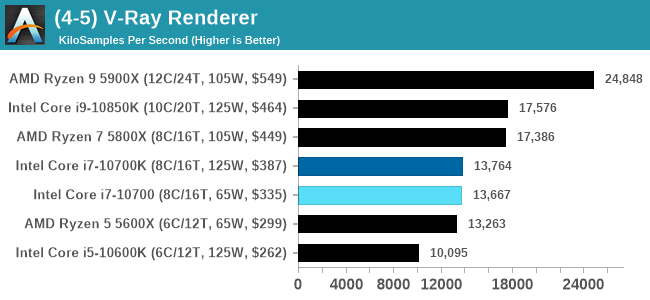
Cinebench R20: Link
Another common stable of a benchmark suite is Cinebench. Based on Cinema4D, Cinebench is a purpose built benchmark machine that renders a scene with both single and multi-threaded options. The scene is identical in both cases. The R20 version means that it targets Cinema 4D R20, a slightly older version of the software which is currently on version R21. Cinebench R20 was launched given that the R15 version had been out a long time, and despite the difference between the benchmark and the latest version of the software on which it is based, Cinebench results are often quoted a lot in marketing materials.
Results for Cinebench R20 are not comparable to R15 or older, because both the scene being used is different, but also the updates in the code bath. The results are output as a score from the software, which is directly proportional to the time taken. Using the benchmark flags for single CPU and multi-CPU workloads, we run the software from the command line which opens the test, runs it, and dumps the result into the console which is redirected to a text file. The test is repeated for a minimum of 10 minutes for both ST and MT, and then the runs averaged.

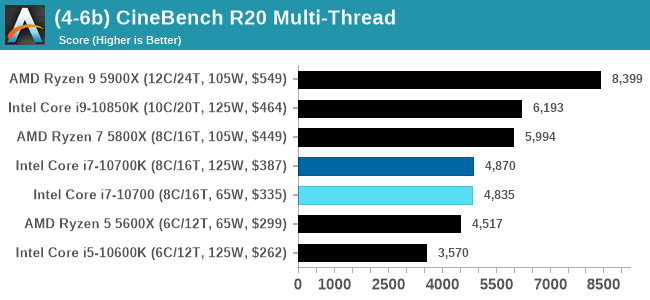
We are still in the process of rolling out CineBench R23 (you can see the results in our benchmark database here), but had not tested it on all the CPUs in this review at this time. It will be added to future reviews.




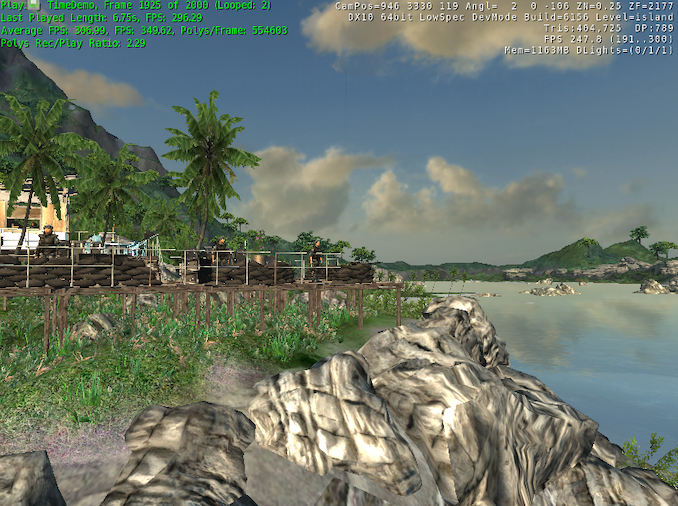











210 Comments
View All Comments
bji - Thursday, January 21, 2021 - link
To clarify: 95% was an exaggeration. Micro Center has like 20 or 30 stores and is accessible by more than 5% of the USA population. But it's probably not more than 20%. Anyway any store that is not available to the majority of people cannot be called "general availability".bji - Thursday, January 21, 2021 - link
I mean seriously. If Micro Center were that easy to get through, would there even be a shortage of these chips at online vendors? Everyone would already be satisfied by the Micro Center supply. But a) the fact that there is online shortage means very clearly that most people can't get one from Micro Center (otherwise they already would have and there would not be zero supply online), and b) if a significant fraction of the population could actually get them from Micro Center, Micro Center would clearly already be sold out also.magreen - Friday, January 22, 2021 - link
@bji: How do you feel about Microcenter?calc76 - Friday, January 22, 2021 - link
I'd suspect its probably well more than 50% of the US population is within an hour drive of a Microcenter. The names of the cities listed on their site aren't all easily recognizable but the metro areas are almost all the large ones.Atlanta
Baltimore
Boston
Chicago
Cincinnati
Cleveland
Columbus
DC
Detroit
Denver
DFW
Houston
Kansas City
LA
Minneapolis
Newark
NYC
Philadelphia
St Louis
Dug - Friday, January 22, 2021 - link
They were actually available today at Amazon for a very long time at @299. Of course it's back up again after mass ordering at the time I'm posting this.bji - Friday, January 22, 2021 - link
I checked several times today. How did I miss that? I doubt it was for a very long time. Probably closer to that 10 minutes I mentioned.jimbo2779 - Friday, January 22, 2021 - link
Nephew bought a 5600x for MSRP here in the UK from Currys which is by far the largest national chain of electronics and computer equipment.You could try signing up for an alerts service, providing you have the funds ready to put down you could likely have one in the next week or so. Not as ideal as next day from any major retailer but the chips are coming in stock.
Spunjji - Friday, January 22, 2021 - link
UK here. They do mention low availability of that chip in the article, but I notice that didn't prevent you coming here to whinge about it anyway.From my perspective in the UK, they have 10+ in stock at Overclockers for £299.99 and unspecified stock at CCL for £309.
I must say I especially enjoyed how you elaborately set up the goalposts in your first post, then moved them around with every response. Good game!
bji - Saturday, January 23, 2021 - link
No goalposts were moved. If you'd care to elaborate, I'd respond. Or were you just whining about my whinging?Spunjji - Monday, January 25, 2021 - link
That last bit. 👍Your original post said that none of the processors have had general availability and that it would be months before prices hit MSRP. People have pointed out a few times that in various parts of the world, availability is there and prices are at (or very near) MSRP, yet you've still found reasons not to admit that maybe you overstated things a bit.